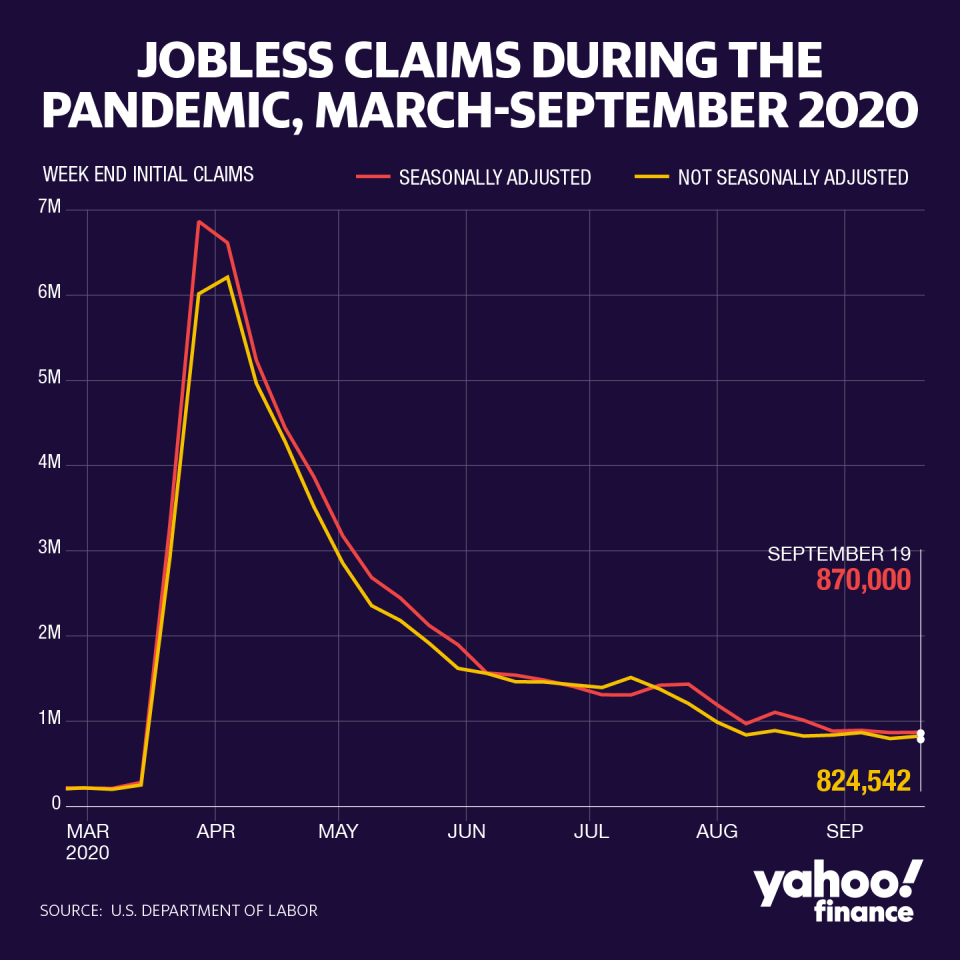Democratic election sweep win would add 7 million more jobs than a GOP one, analysis finds
A Democratic sweep this election cycle would bring a faster recovery to the job market than a Republican one, according to a new analysis, adding millions of more jobs, shrinking the unemployment rate faster, and boosting the number of workers in the labor force higher.
Read more: Coronavirus: How to find a job after a layoff
Under a scenario where Democratic presidential nominee Joe Biden wins the presidency and both the Senate and the House of Representatives are controlled by Democrats, 18.6 million jobs would be added by 2024, according to the analysis from Moody’s Analytics.
Under the opposite scenario where President Donald Trump wins a second term and Republicans control both chambers of Congress, 11.2 million jobs would be created.
“Biden would implement much more aggressive fiscal support to the economy early on in his administration,” Mark Zandi, Moody's Analytics chief economist who co-authored the report told Yahoo Money. “That provides a lot of juice to the economy early on in his term.”
The unemployment rate would recover much quicker under Democratic control, too, falling to 5.2% in 2022 compared with just 7.1% in a Republican-sweep scenario. The participation rate would also increase faster under the Democrats, reaching 63.6% in 2024, versus 62.1% in the Republican scenario.

The results change if opposite parties control Congress and the executive branch. If the Senate is controlled by Republicans and the House by Democrats, a presidential win by Biden would add 13.6 million jobs to the economy by 2024. If Trump wins, the Senate is under Republican control and the House under Democratic, the economy would create 11.8 million jobs.
In all the iterations, a Biden win would mean more jobs.
Biden’s economic policies suggest aggressive government spending, which would be financed by higher taxes on corporations and budget deficits. But that is offset by the benefits of the long-term economic growth, according to Zandi’s analysis.
“Biden borrows more, which is not as big of a problem because interest rates are at zero and the Federal Reserve has said they'll remain there for the foreseeable future,” he said. “That makes it a lot easier to run larger deficits to support the economy and get the economy back to full employment.”
‘Trump has proposed very modest support’
Even though the government would borrow more under the Democrats, the federal debt-to-GDP ratio wouldn’t be much different if Republicans were in control. The ratio — a key measure of a country's ability to pay off its debt— would be 129.7 under Biden and the Democrats by 2030 and 126.7 under Trump and the GOP.

“The Democrats are spending more, deficits are larger, but the GDP rises,” Zandi said. “The net impact of that is basically you land in the same place with regard to the nation's debt load 10 years from now.”
Infrastructure would boost the economy the most in the short term, and Biden’s more aggressive spending in that area would fuel a quicker recovery.
Read more: Here’s what you need to know about unemployment benefits eligibility
Biden’s proposal calls for $2.4 trillion of infrastructure spending over the next decade, while Trump proposes an infrastructure plan worth $1 trillion over the same period, which would be offset by spending cuts.
“Trump has proposed very modest support to the economy,” Zandi said. “The only major spending initiative is around infrastructure, which is much smaller than Biden's proposal.”
‘The other policy that lifts employment quickly is immigration’
Immigration policies are also important for a brisk recovery of the labor market.
“The other policy that lifts employment quickly is immigration,” Zandi said. “The more immigrants you have, both skilled and unskilled, it adds to the labor force and productivity growth and they quickly support economic activity.”
Biden’s immigration policy would increase the size of the workforce and help the recovery of the job market.

If Trump continues to pursue highly restrictive immigration policies in his second term, this would slow growth in the labor force and productivity, the analysis found. Trump’s policies would potentially decrease net immigration to 500,000 annually in his second term, or just half of what it was on average in the quarter-century prior to his administration.
Trump’s anti-trade policies is another reason why the recovery would be slower under a Republican sweep, according to Zandi, hurting sectors such as agriculture, manufacturing, and transportation.
“[Trump] takes a very anti-trade policy position,” Zandi said.” We're assuming he's going to re-engage with these tariff wars, especially with China, and that does a lot of damage to the labor market.”
Denitsa is a writer for Yahoo Finance and Cashay, a new personal finance website. Follow her on Twitter @denitsa_tsekova.
Read more:
Follow Yahoo Finance on Twitter, Facebook, Instagram, Flipboard, SmartNews, LinkedIn, YouTube, and Reddit.

 money
money 

